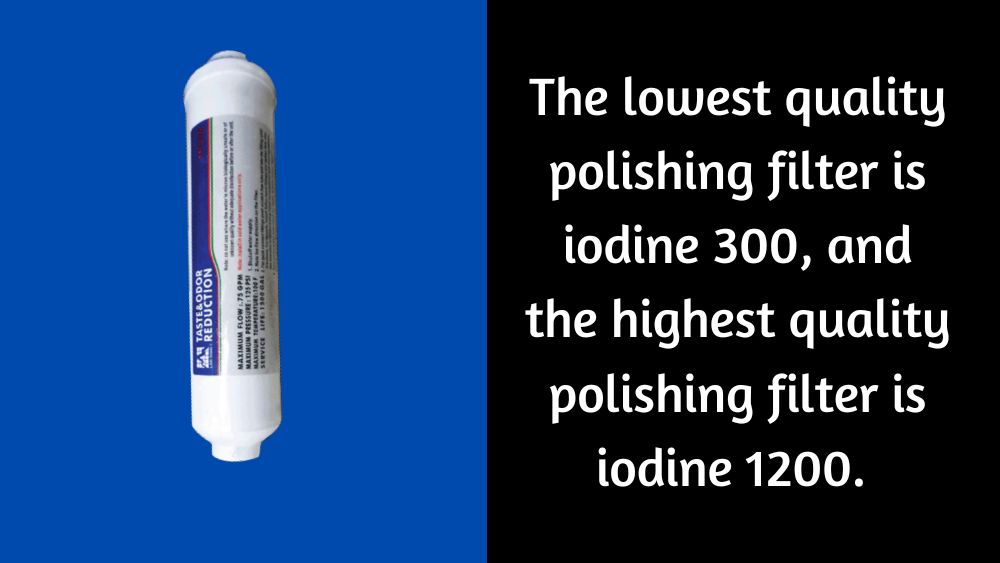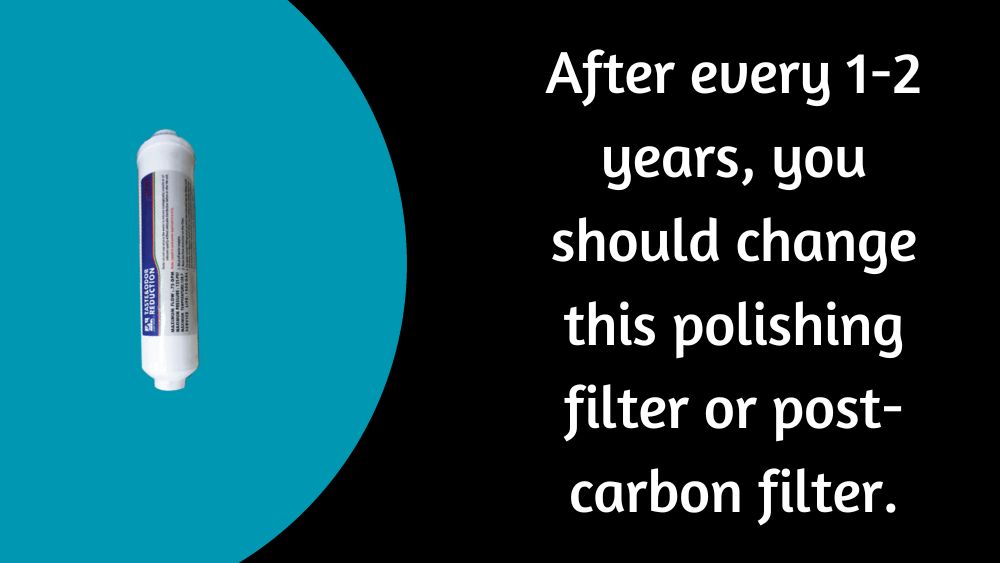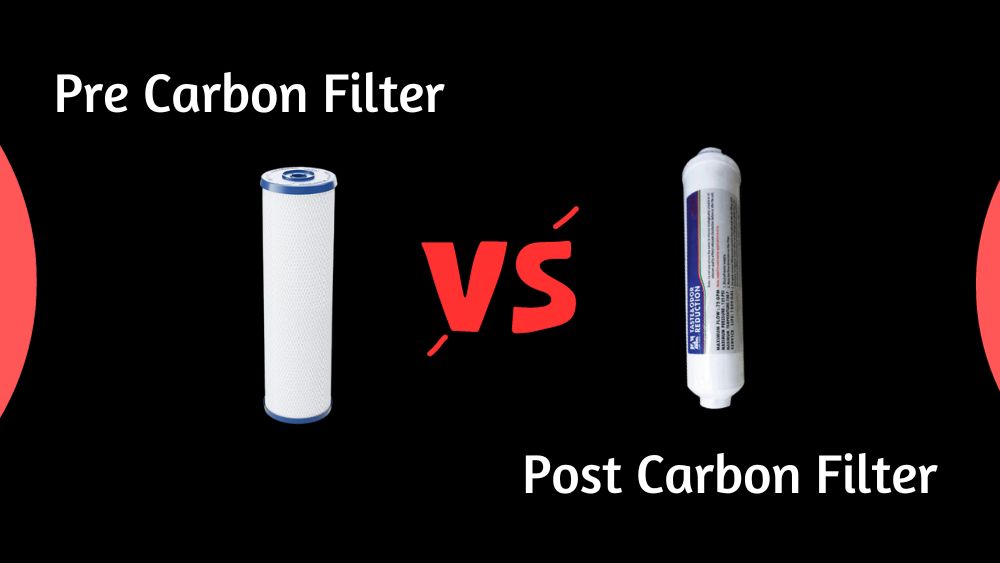A polishing Filter or post-carbon filter (T33) absorbs fumes or halogens, improves the taste of potable water, and increases bleach content. It is designed to remove unwanted tastes, odors, and organic compounds from your water before it is consumed.
This filter utilizes activated carbon to absorb any impurities in the water and is the final step in your RO process (except UV light and Mineral Filter). The polishing filter (T33) is necessary to improve your water’s overall taste and quality and can significantly reduce chlorine, taste, and odor. Polishing filters are usually made of activated carbon powder, which helps to absorb and remove small particles and other pollutants that the RO membrane may have missed. This filter will also help protect the other components within your RO system from any chemical damage.
How to Measure the Best Quality Polishing Filter?
The iodine number measures the effectiveness of the polishing filter (T33 filter). Iodine number refers to the amount of Iodine (negative ion) absorbed by one gram of carbon. Iodine numbers indicate purity, absorption capacity, effective range, fineness of pores, etc. The lowest quality polishing filter is iodine 300, and the highest quality polishing filter is iodine 1200. The technical features of polishing filters are-
- The maximum operating pressure is between 14.5 and 58 psi
- The ambient temperature ranges from 5-40 degrees Celsius/41-104 degrees Fahrenheit

Pre Carbon Filter vs. Post Carbon Filter (Polishing Filter)
Carbon and post-carbon filters are the most common filters used in RO water filtration systems for homes and businesses. Carbon filters are typically used in 2nd stage of the RO system and work to remove chlorine, dissolved gases, odors, and other contaminants from the water.
A post-carbon filter is then used to polish the water to reduce any remaining contaminants further. The main function of the polishing filter is to increase the taste of water.
Both filters are important to ensure clean, safe, and great-tasting water. Ultimately, the type of filter used should be based on the specific impurities present in the water being filtered.
Activated Carbon Filter
Features
- Made of Granular Activated Carbon
- Lifespan is approximately one year
- Get rid of chlorine, dissolved gases, bad taste, and odor
- Use before the RO membrane
Polishing Filter
Features
- Made of Carbon Powder
- Lifespan is approximately one year to two years
- Increase the taste of water
- Use after the RO membrane
The Pre Carbon Filter, placed before the RO membrane, primarily focuses on removing large particles, sediment, and certain chemical impurities, safeguarding the RO membrane from clogging. On the other hand, the Post Carbon Filter, situated after the RO membrane, is dedicated to enhancing the taste and odor of the treated water by effectively eliminating volatile compounds like chlorine.
| Pre Carbon Filter in RO System | Post Carbon Filter in RO System |
|---|---|
| Placement in RO System: | Placement in RO System: |
| Pre Carbon Filters are typically installed before the Reverse Osmosis (RO) membrane, serving as the initial stage of filtration. | Post Carbon Filters are usually the final stage in an RO system, placed after the RO membrane and other filters. |
| Purpose: | Purpose: |
| To keep the RO membrane from clogging and prolong its life, pre-carbon filters mostly concentrate on eliminating bigger particles, silt, and certain chemical contaminants. | Post Carbon Filters are designed to enhance the quality of the treated water by removing volatile compounds, such as chlorine odor and taste, as well as residual chemicals, to provide better-tasting and odor-free water. |
| Filtration Stage: | Filtration Stage: |
| Pre Carbon Filters are typically the first stage in an RO system. | As the last component of a RO system, post carbon filters guarantee that the water is better prepared for ingestion. |
| Contaminant Removal: | Contaminant Removal: |
| Pre Carbon Filters reduce sediment, rust, chlorine, and some chemicals, mainly focusing on water purity and protecting the RO membrane. | The primary purpose of post carbon filters is to eliminate residual chemicals and the taste and odor of chlorine, greatly improving the taste and odor of treated water. |
| Filter Media: | Filter Media: |
| Pre Carbon Filters may use activated carbon or sediment filters as the primary filter media. | These filters primarily utilize Granular Activated Carbon (GAC) as the filter media to effectively remove volatile compounds. |
| Impact on Water Quality: | Impact on Water Quality: |
| Though they have no effect on flavor or odor, pre-carbon filters are essential for preserving water purity and protecting the RO membrane. | Polishing Filters are essential for improving the taste and odor of the treated water, enhancing the overall water quality for consumption. |
| Replacement Frequency: | Replacement Frequency: |
| Pre Carbon Filters are generally replaced less frequently than post carbon filters since they primarily deal with larger particles. | Because post carbon filters are exposed to chemicals and volatile substances that shorten their lifespan, they usually need to be replaced more frequently. |

Does a polishing filter increase the taste of water?
Yes, a polishing filter increases the taste of water. After RO filtration, polishing filters (post-carbon filters or T33) are used. Post-carbon filters use activated carbon power to absorb some impurities and leave behind water that has a better taste and is odorless.
When to change the post-carbon filters?
After every 1-2 years, you should change this polishing filter or post-carbon filter. Only RO-purified water passes through the polishing filter, so it doesn’t require as much maintenance as other filters.
What do pre-carbon filters and post-carbon filters target in terms of contaminant removal?
Pre Carbon Filters reduce sediment, rust, chlorine, and certain chemicals, focusing on maintaining water purity and safeguarding the RO membrane. Post Carbon Filters mainly remove chlorine odor and taste, along with residual chemicals, significantly improving water taste and odor.
How can I tell if my Post Carbon Filter needs replacement?
Post-carbon filters typically need replacement when you notice a decline in water taste and odor. Manufacturers often provide recommended replacement intervals, which should be followed to maintain water quality.
Final Words
In conclusion, a T33 polishing filter can be valuable to any home RO water filtration system. Removing unwanted tastes and odors can improve the taste of potable water and increase bleach content.

Hasan Al Sarker is a Reverse Osmosis Specialist. He has worked for many years to ensure safe drinking water for all. His research paper has been published in several journals, including Issue, Medium, and Slideshare. He is recognized as a water doctor among specialists though he did not attend medical college.
Besides working as a researcher of reverse osmosis technology, he is also very fancy with the kitchen and cooking. His guides are reading thousands of people every day. As a head of content, he is responsible for all the published articles at RO System Reviews.

